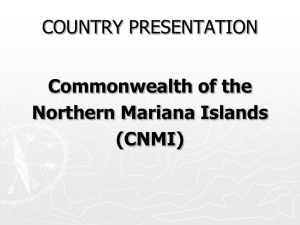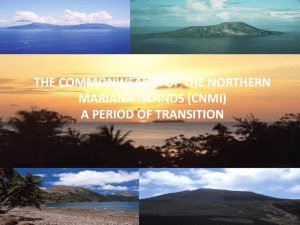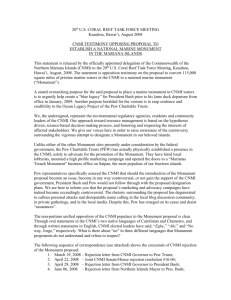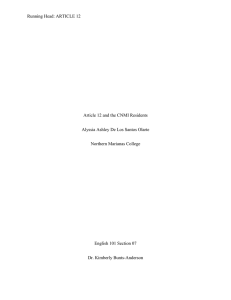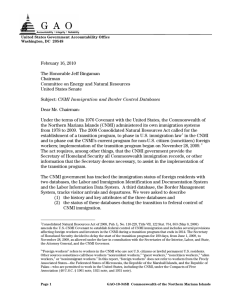CNMI Economic Model Public Presentation
advertisement
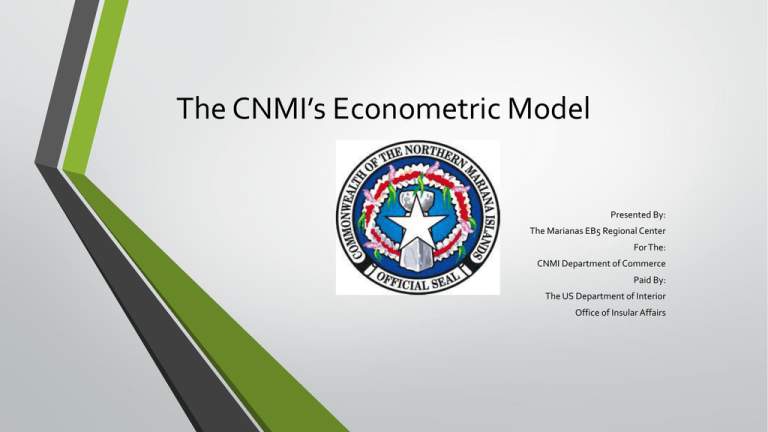
The CNMI’s Econometric Model Presented By: The Marianas EB5 Regional Center For The: CNMI Department of Commerce Paid By: The US Department of Interior Office of Insular Affairs Model Background Who, What, Why & How • Background The CNMI’s Economic Modeling • Outdated and inconsistent with current economic realties • • Doesn’t reflect impact of loss of manufacturing & tourism changes Current Economic Measures • 2007 & 2010 Gross Domestic Products • • Produced by the US Bureau of Economic Analysis Provides a true measure of economic health • • Economic Indicators • • • Estimates are hindered by data gaps and the need to extrapolate data made available State-level collection of economic markers which provide a sense of economic condition Not consistently collected and reported Consumer Price Index • • State-level collection of prices in specific “market baskets” which gauge inflationary changes to general consumer commodities Historically only collected on Saipan, which didn’t reflect nature of inter-island price fluctuations for the specific time collected • Recently developed Tinian & Rota CPI’s to account for actual changes in those specific economies Need for a Model • To forecast impacts of specific projects, proposals and/or policy decisions • Useful in understanding multiplier impacts of specific economic activity • • Useful in forecasting impacts of policy implementation specific to the economic condition • • Example: How many jobs a specific development will create (Direct, Indirect & Induced) Example: How will changes to tax laws or structure impact revenues Useful in the application/evaluation of economic development programs • • The CNMI’s Qualifying Certificate Program Free Trade Zone Incentives CNMI Steps • CNMI Department of Commerce • • • • Primary government entity for reporting economic condition through its Central Statistics Division Applied for a Technical Assistance Grant from the US Department of Interior, Office of Insular Affairs Placed RFP12-DOC-064 Contract awarded to the Marianas EB5 Regional Center • • Economist: Dr. Michael K. Evans of Evans, Carroll & Associates Contractor report to Governor Inos in June 2013 • Identified data gaps and discussed impact to the economic model CNMI’s Economic Model • Model Summary • Model was developed without specific time series data points (2003-2010) • • • Attempts to extrapolate data utilizing from the BEA, Economic Census & CNMI data, however too many inconsistencies existed to make extrapolation useful Availability of 2011 GDP estimates from BEA • • • Wages & employment: Impacts the wage/employment sections of the model Anticipated release of 2011 GDP estimates will include revisions to 2009 & 2010 data CNMI’s model will be recalculated once the revisions are made available Tourist spending data • • MVA data provide tourist arrivals, however spending patterns per market are not available If data collection occurs specific to tourist spending, model can accommodate changes to include these data points Model Elements Equations & elements of the CNMI Model Model Framework Categories Utilized In Model Framework Consumption Gross Domestic Product Fixed Investments Employment Export of goods Wages Export of services Consumer Price Index Import of goods Implicit GDP Deflator Import of services Domestic personal disposable income Federal government consumption & investment Foreign measures of personal income Territorial government consumption & investment Exogenous variables* Foreign variables for Japan, China & Korea and includes values of the currencies & real GDP for those countries. Key variable: Number of Visitors Impacts: Total Demand Consumption Charts: Consumer Durables 160 150 140 12 130 8 120 110 4 100 0 -4 -8 2003 2004 2005 2006 Residual 2007 Actual 2008 Fitted 2009 2010 • Excludes spending patterns of Japanese visitors • Represents shopping patters in which consumers purchase genuine products vs. counterfeit products in their home country Consumption Charts: Consumer Non-Durables 280 260 240 220 • Consumption closely tied to current conditions 200 20 180 10 0 -10 -20 2002 2003 2004 2005 Residual 2006 2007 Actual 2008 Fitted 2009 2010 Consumption Charts: Consumer Services 480 440 400 360 8 320 4 280 0 -4 -8 -12 2003 2004 2005 2006 Residual 2007 Actual 2008 Fitted 2009 2010 • When housing expenditures rise, purchases of fuel & household non-durables (utilities, etc.) rise • Increases in non-durables may serve as the cause of housing expenditure increases. Consumption Charts: Net Foreign Travel 480 440 400 • Equation developed to maintain consistency with BEA statistics • Similar to export of services 360 8 320 4 280 0 -4 -8 -12 2003 2004 2005 2006 Residual 2007 Actual 2008 Fitted 2009 2010 Fixed Investment Equation • Includes housing & capital spending • Population decline consistent with the need for housing • Capital spending primarily for tourism based investments with the exit of the garment manufacturing industry • Visitor arrivals critical independent variable for this equation Export Charts 320 280 240 200 0.8 160 • • Goods export is minimal and statistically insignificant Export of services is closely tied to tourism and visitor arrivals • 0.4 0.0 -0.4 -0.8 -1.2 2002 2003 2004 2005 Residual 2006 2007 Actual 2008 Fitted 2009 2010 Data similar to Net Foreign Travel (Consumption) Export: Visitor Arrivals Japan • China/Korea Decline consistent with JAL pullout and fluctuation with Japan’s Real GDP 13.0 280,000 12.8 240,000 12.6 200,000 12.4 .15 12.2 .10 12.0 .05 11.8 .00 20,000 160,000 10,000 120,000 0 -.05 -10,000 -.10 -20,000 -.15 2003 2004 2005 2006 2007 2008 2009 2010 2011 2012 Residual Actual Fitted 02 03 04 05 06 Residual 07 08 Actual 09 10 Fitted 11 12 Imports 1,000 • 800 Total demand is difficult to measure due to scarcity of data • • Employee compensation is used to measure aggregate demand Exports of goods are more clearly linked to imports due to the need to import raw materials 600 40 400 20 200 0 -20 -40 -60 2002 2003 2004 2005 Residual 2006 2007 Actual 2008 Fitted 2009 2010 Government Consumption Territorial • • Federal consumption is statistically insignificant Wages are used as a proxy for aggregate demand Manufacturing Compensation • • Manufacturing wages are closely tied to export of goods Decline consistent with garment manufacturing exit Compensation for Government Workers, Territorial • Boosts in visitors increases the need for local services, which accounts for the rise in 20092010 Private Sector Wage • • • Excludes manufacturing & government wages. Usually separated into several sectors, but due to data gaps, CNMI’s model is unable to provide sector specific information CNMI’s model utilizes the CPI as a correlation value versus standard output measures Implicit GDP Deflator • Constructed to close the gap between current & constant dollar GDP Consumer Price Index for CNMI • 1% increase in minimum wage= 0.3% in CPI Final Five Equations • • Not estimated stochastically 2010 Employment in manufacturing , trade, hotels, and restaurants, all other private, and government to relevant components of GDP. • • • • • • EM = XGX * 39/17 ETR = (CDX + CNX) * 3495/313 HER = XSX * 5779/180 EOTH = (CSX + IPX) * 12220/331 EG = GSLX * 5277/300 E= EM + ETR + HER + EOTH + EG Utilizing the Model to Forecast Simulation of a $10,000,000.00 injection into the CNMI economy Forecast Simulation & Results • Considered a forecast despite having known variables (visitor arrivals), due to pending release of GDP account figures • • Current GDP for 2011 & 2012 to rise from 4.1% change from 2010 (last known results) Constant GDP for 2011 & 2012 to rise from 0.9% in 2011 to 6.0% in 2012 • Increase in GDP for 2011 & 2012 due to increase in visitor arrivals of 20,000 • Model Simulations • Both test an impact of $10,000,000.00 into the CNMI economy • • First scenario arrives at the $10,000,000.00 via an increase in visitor arrivals of 20,000 Second scenario arrives at the $10,000,000.00 via an increase in capital spending Economic Impact of an Increase 20,000 Visitors • Assumptions of model • Average visitor spends roughly $500.00 x 20,000 visitors= $10,000,000.00 • Simulation Purpose • Simulation looks at the economic impact of an additional 20,000 visitors and its impact to overall economic impact over a three year period • Results of Simulation • Increase of three year increase of $12 Million in first year, $17 Million in second year & $20 Million in third year of a $10,000,000.00 “shock” into the CNMI economy • Multiplier for an increase of 20,000 visitors into the CNMI economy is 2.0 over three years Economic Impact of an Increase in Capital Spending of $10 Million • Multiplier is 1.2 versus 2.0 (increase in visitor arrivals) • Capital spending multiplier is lower due to the need to import goods, whereas tourism based increase is higher due to the amount of domestic spending. • • Money is remitted out of the local economy in import expenditures The impact of tourism spending creates and sustains higher employment numbers vs. capital spending
